Decibles Of A C40 Compact Jaw Crusher
The Sound of Efficiency: Understanding Decibel Levels in the McCloskey C40 Compact Jaw Crusher
In the demanding world of aggregate processing and recycling, compact crushers like the McCloskey C40 offer unparalleled versatility for confined spaces and smaller-scale operations. While its size and crushing prowess are often highlighted, a crucial factor impacting both operator well-being and site compliance is its acoustic footprint – specifically, its decibel (dB) level.
Why Decibels Matter in Crushing
Noise isn't just an annoyance; it's a significant operational consideration:

1. Operator Health & Safety: Prolonged exposure to high noise levels leads to Noise-Induced Hearing Loss (NIHL), tinnitus, increased stress, and fatigue.
2. Regulatory Compliance: Most regions enforce strict workplace noise exposure limits (often around 85 dB(A) averaged over an 8-hour shift). Exceeding these can lead to fines and operational shutdowns.
3. Community Relations: Especially for urban recycling yards or sites near residential areas, excessive noise can generate complaints and damage community goodwill.

4. On-Site Communication: High ambient noise makes clear communication between workers difficult and hazardous.
The C40 Compact Jaw Crusher: Measuring the Sound
The McCloskey C40 is designed as a highly mobile, track-mounted jaw crusher capable of handling hard rock, concrete demolition debris, asphalt recycling, and aggregates production.
So, how loud is it?
Typical Operating Range: Under standard load conditions processing typical materials like concrete or medium-hard rock, the C40 generally operates within a range of approximately 100 dB(A) to 110 dB(A) measured at the operator's position or very close to the machine itself.
Context is Key: This places it firmly in the "Very Loud" category on the decibel scale:
Comparable to: A chainsaw (approx. 110 dB), a rock concert (approx. 110-120 dB), or heavy truck traffic.
Significantly louder than: Normal conversation (~60 dB), busy street traffic (~80 dB).
Significantly quieter than: Large stationary primary jaw crushers which can exceed 115-120+ dB(A).
Factors Influencing Noise Levels:
The actual sound level experienced on-site can vary depending on several factors:
1. Material Being Crushed: Harder rocks generate more impact noise than softer materials like recycled concrete.
2. Feed Size & Consistency


